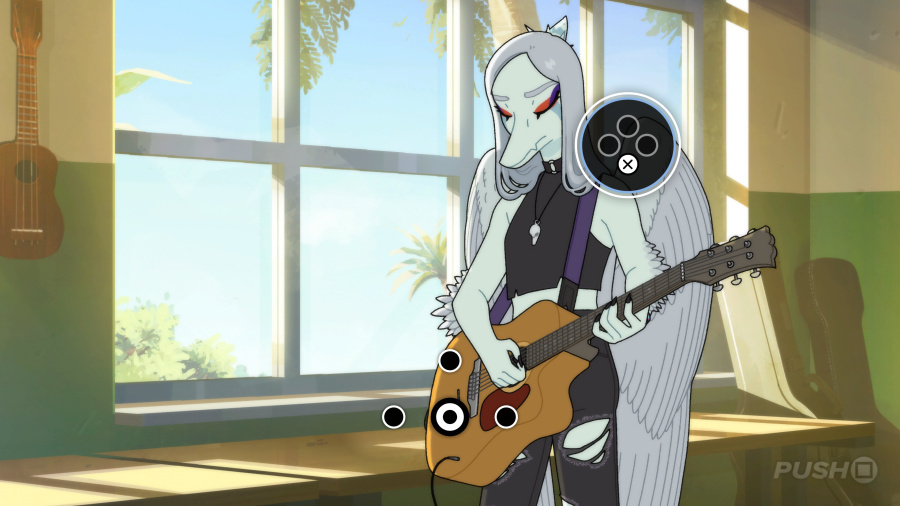[ad_1]

Canadian developer KO_OP has been away from Sony’s ecosystem for quite a while. Its first game, GNOG, launched on PS4 back in 2017 and is a fun, colourful puzzler that works great in PSVR. Fast forward a number of years, and they’ve returned to PlayStation with Goodbye Volcano High, a visual novel about the hardships of discovering oneself with an impending global catastrophe serving as a backdrop.
Goodbye Volcano High is a decidedly bizarre but unique amalgamation of ideas, being equal parts School of Rock, Don’t Look Up, and the Jim Henson show Dinosaurs. If such an odd mashup doesn’t hook you, then the writing most certainly will. In a world where everyone is an anthropomorphised dinosaur, you play as Fang, a student with a goth aesthetic and a penchant for making music. The game opens with you starting your senior year at Volcano High School, getting to grips with what you’re going to do with your future. You’ll also be trying to win a Battle of the Bands competition alongside bandmates Trish and Reed. Early on in the game, you start noticing everyone’s cell phones are experiencing inconsistent bouts of inexplicable electromagnetic interference. For the sake of spoilers, we won’t say what the cause is, but the ramifications of it will hang over the entirety of the six hours you’ll spend with this motley crew of characters.

It’s almost a shame that the title isn’t longer, as the character writing is the brightest spot amid a myriad of quality elements. While the primary narrative is no slouch, the character writing is impeccable. Every single core character in this game is great. Whether it’s Fang, her bandmates, her younger brother, or those on the fringe of her core friend group, everyone gets a moment in the spotlight. Each character has a vibrant, distinctive look and unique and marvellously defined personalities that allow them all to stand apart from one another without crowding the story. It’s rare that a game delivers this many memorable characters this effectively, especially over such a short period of time.
And that’s to say nothing of the subtlety and nuance of the minute-to-minute writing, capable of deftly conveying numerous complicated ideas and emotions with expert levels of clarity and engagement. The final act of the game in particular is jam-packed with incredible writing, delivering emotional wallops one after another so quickly you’ll hardly be able to catch your breath. The final hours of the game in particular are really special, deftly balancing a touching melancholy with sudden delicious bursts of ecstasy. As the game is largely a visual novel, it makes some sense that the writing is executed to such a high level, but even with those expectations in mind, we were blown away.
Less impressive is the rhythm gameplay. Outside of dialogue choices, the rhythm elements are the only other real gameplay you’ll run into, and it leaves much to be desired. The timing on them feels a little off — though there is a comfort setting to relax this somewhat — but more importantly, they don’t have the clean UI you’d expect from a quality rhythm title. Instead, you have to exercise vigilance, as alongside a regular note chart that requires you to move the thumbstick to the appropriate spot, you have what amount to QTEs to contend with as well.
Gameplay
Assists
Controls
Visual
Audio
Content
Full Accessibility Report
Data by Family Gaming Database
The real kicker is that they don’t happen in select areas on the screen, showing up in what feels like completely random spots, sometimes even requiring you to dart back and forth across the screen. It’s maddening and not at all conducive to getting into a rhythm with any of the music being played.
Luckily these gameplay segments aren’t super frequent and don’t hinder the experience much. This hiccup stings even less when accounting for the fact the music is phenomenal. While the regular score is great, all of the original music for Fang’s band, Worm Drama, is even better, adding yet another bright spot to such a shining experience. The voice work is great beyond the music too, with each and every performance providing its own unique charm, further helping the already-memorable characters stand out that much further. This goes hand in hand with the truly excellent environment design, which makes great use of colour and detail to enliven a game that could be flat and boring in other hands.

Beyond this, there’s only one other fairly important thing to talk about, but if you’re reading this review farther out from release, you hopefully won’t have to worry. This game has the least functional Trophy list we’ve ever seen. Of the 38 Trophies in the game — many of them unmissable and progress-related — our full playthrough of the game saw us unlock one single solitary Trophy. This is something that should be a pretty easy fix in practice, but why was it in such a state to begin with? One or two bugged Trophies is one thing, but the entire list? If you’re a Trophy hunter, you’ll definitely want to wait a bit before digging into this one.
Conclusion
Goodbye Volcano High is an absolute delight. While the rhythm gameplay segments are a bit of a nuisance by way of their design, the only other real issue is the sorry state of the Trophy list, something that should be easily remedied. If you can look past those fairly minor hitches, then what you’ll experience is an exceptionally written game filled out by a cast of characters without so much as a weak link. Combine the incredibly impressive roster of characters with the high caliber of writing capable of delivering an emotional gut-punch just as easily as raucous laughter, this is not one worth sleeping on.
[ad_2]
Source link




















